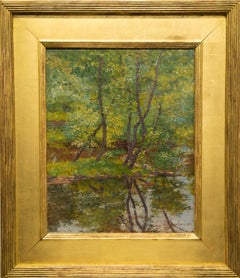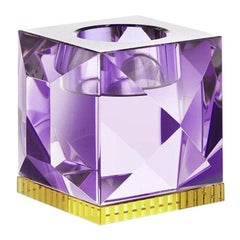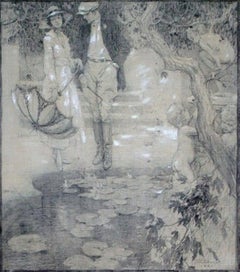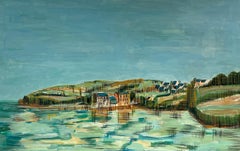Summer Reflections
to
8
50
22
57
33
15
5
4
3
2
2
2
1
1
1
1
5
5
3
3
3
Sort By
19th Century Painting 'Summer Reflections' by William Stephen Coleman
By William Stephen Coleman
Located in London, GB
‘Summer Reflections’ Painting by William Stephen Coleman
Depicts two young girls sitting and
Category
Antique 19th Century English Victorian Paintings
Materials
Canvas
XL Summer Reflections II 60 x 60 cm, Painting, Oil on Canvas
By Susan Wooler
Located in Yardley, PA
XL Summer Reflections II 60 x 60 cm Impasto, deep textured oil painting Inspired by Monet
Category
2010s Impressionist Paintings
Materials
Oil
$540
H 23.6 in W 23.6 in D 1.8 in
Henry Wallace Methven "Impressionist Landscape" Water, Trees Summer Reflection
Located in Detroit, MI
Impressionist Landscape" is an exquisitely peaceful late summer scene along the banks of a quiet
Category
Early 1900s Impressionist Landscape Paintings
Materials
Canvas, Oil
Ophelia Purple Crystal T-Light Holder, Hand-Sculpted Contemporary Crystal
By Reflections Copenhagen
Located in Geneve, CH
purple and yellow; a color combination which releases a feeling of summer.
Reflections Copenhagen, a
Category
2010s Danish Post-Modern Candlesticks
Materials
Crystal
$383 / item
H 3.08 in W 3.55 in D 3.55 in
Reflections of a Summer Past
By Maurice L. Bower
Located in Fort Washington, PA
Signed Lower Right
Category
1920s Landscape Drawings and Watercolors
Materials
Canvas, Charcoal, Pastel
Tranquil Reflections – Swedish Summer Landscape by Olof Arborelius
Located in Stockholm, SE
the serene stillness of a summer’s day, likely set in the lush surroundings of the Uddevalla region on
Category
Early 20th Century Post-Impressionist Landscape Paintings
Materials
Canvas, Oil
$2,792 Sale Price
20% Off
H 16.93 in W 20.87 in
1950's Summer Blue Coastal Village Reflection French Landscape
By Bernard Labbe
Located in Cirencester, Gloucestershire
Coastal Village Reflections
by Bernard Labbe (French mid 20th century)
original gouache on artist
Category
Mid-20th Century Modern Landscape Paintings
Materials
Gouache
$583 Sale Price
30% Off
H 14 in W 21.5 in
"Summer Afternoon", contemporary, boats, reflections, water, blues, oil painting
By Marcia Wise
Located in Natick, MA
Marcia Wise's "Summer Afternoon" is a 24 x 36 inch oil painting full of color, from ochres and
Category
2010s Contemporary Landscape Paintings
Materials
Oil
$2,850
H 24 in W 36 in D 0.75 in
Fine British Original Impressionist Watercolor Summer Bridge River Reflection
Located in Cirencester, Gloucestershire
Summers Landscape
by Anthony Avery (British 1946-2023) * see notes below
original watercolor on
Category
Early 2000s Impressionist Landscape Paintings
Materials
Watercolor
$314 Sale Price
30% Off
H 11 in W 15 in
Catching memories (Reflections of Summer), Painting, Acrylic on Canvas
By Nestor Toro
Located in Yardley, PA
This artwork was created layering and blending thick layers of many colors, completed with iridescent silver effects and bright yellow! Ready to hang, signed. I include a certi...
Category
21st Century and Contemporary Abstract Abstract Paintings
Materials
Acrylic
$4,000
H 30 in W 40 in D 0.7 in
Summer Pond - contemporary landscape circle pointillism reflection park painting
By Ewa Adams
Located in London, GB
framed size: 87 x 87 cm
Ewa Adams is a landscape painter. Her painting is a contemporary take on Pointillism. She builds her images out of circles of pure colour juxtaposted next t...
Category
2010s Contemporary Landscape Paintings
Materials
Canvas, Acrylic
$3,505
H 23.63 in W 23.63 in D 1.58 in
"Summer Sojourn 1" Woman in Orange Bikini Swimming with Reflections on Water
By Carol Bennett
Located in Edgartown, MA
"Summer Sojourn 1" Woman in Orange Bikini Swimming with Reflections on Water
“I have an open and
Category
2010s Figurative Paintings
Materials
Oil, Wood Panel
Summer Cloud Reflections On The River Original 20th Century British Oil Painting
By Mervyn Goode
Located in Cirencester, Gloucestershire
Artist/ School: Mervyn Goode (British, b. 1948), signed lower right
Title: Tranquil Pastoral Landscape with Cattle grazing
Medium: signed oil painting on canvas, framed.
Size:
...
Category
20th Century Impressionist Landscape Paintings
Materials
Oil, Canvas
$1,177 Sale Price
30% Off
H 14.75 in W 18.75 in
Soul Underground, Lithuania, 2015
By Mindaugas Gabrenas
Located in Hudson, NY
aesthetic.
Black and White, Water, Ocean, Men, Lithuania, Silhouette, Boat, Summer, Reflection, Sun, paddle
Category
2010s Contemporary Black and White Photography
Materials
Archival Pigment
Miami Crystal T-Light Holder, Hand-Sculpted Contemporary Crystal
By Reflections Copenhagen
Located in Geneve, CH
increase the summer feel.
Reflections Copenhagen, a collection of handmade decorative mirrors and
Category
2010s Danish Post-Modern Candlesticks
Materials
Crystal
$728 / item
H 7.8 in W 3.15 in D 3.15 in
Soul Underground, Hamptons, NY, 2015
By Mindaugas Gabrenas
Located in Hudson, NY
, Silhouette, Boat, Summer, Reflection, Sun, paddle, Surfer, sea, Hamptons, surf, sea, seaside
Category
2010s Contemporary Black and White Photography
Materials
Photographic Film, Silver Gelatin
Soul Underground
By Mindaugas Gabrenas
Located in Hudson, NY
.
Black and White, Water, Ocean, Men, Lithuania, Silhouette, Boat, Summer, Reflection, Sun, paddle, paddle
Category
21st Century and Contemporary Contemporary Black and White Photography
Materials
Photographic Film, Silver Gelatin
Summer on the Lake, Original Painting
Located in San Francisco, CA
, boats, sky, mountains, pine, bright, summer, season, reflection, happy, architecture, pop, acrylic
Category
21st Century and Contemporary Pop Art Interior Paintings
Materials
Acrylic
F. McA - 20th Century Oil, Summer Vase
Located in Corsham, GB
This delightful abstract study depicts a round vase filled with colourful summer flowers
Category
20th Century Abstract Paintings
Materials
Oil
Summer, Original Painting, landscape, Seascape, Coastal, Cornwall
By Nicola Mosley
Located in Deddington, GB
light reflections. Memories of summer, coastal sunrises and sunsets have been the inspiration for this
Category
2010s Contemporary Landscape Paintings
Materials
Oil
$946
H 16.93 in W 16.93 in D 1.97 in
Summer Morning Original Village Sunny Landscape Oil Painting by Andrei Belaichuk
Located in Zofingen, AG
colors convey the freshness and brightness of a summer morning, and the reflection of sunlight gives the
Category
21st Century and Contemporary Impressionist Landscape Paintings
Materials
Oil, Canvas
$3,249
H 19.69 in W 31.5 in D 0.79 in
Romantic Autumn Collection (still life painting)
By John McCormick
Located in Wilton Manors, FL
, Provenance, Seattle, WA 2019 Harris Harvey Gallery, Summer Reflections, Seattle, WA 2018 Harris Harvey
Category
1980s Realist Still-life Paintings
Materials
Oil
$600 Sale Price
20% Off
H 4 in W 7 in D 1.5 in
Charming Vintage Seaside Oil Painting of Children Playing — Signed SB, Framed
Located in Palm Coast, FL
vivid, with calming blues and warm skin tones that evoke the warmth and freedom of summer. The
Category
20th Century Impressionist Landscape Paintings
Materials
Oil
$580
H 29.5 in W 35.5 in D 2 in
Lake Erwin, Original Painting
Located in San Francisco, CA
, bright, sky, alpine, lake, reflection, rock, summer, season, water, forest, impressionism, nature
Category
21st Century and Contemporary Impressionist More Art
Materials
Watercolor
Near Wild Heaven
Located in West Hollywood, CA
, she skillfully conjures the ambiance of a sun-soaked summer day, inviting nostalgic reflections
Category
2010s Abstract Geometric Abstract Paintings
Materials
Acrylic
Leisure Lake Early Morning, Oil Painting
By Onelio Marrero
Located in San Francisco, CA
subject of water and reflections. In this piece, he captured the feel of a brilliant summer morning.
Category
21st Century and Contemporary Impressionist More Art
Materials
Oil
Lake Champlain Sailing, Original Painting
Located in San Francisco, CA
her.Words that describe this painting: lake, water, sailing, clouds, shore, reflections
Category
21st Century and Contemporary Impressionist More Art
Materials
Acrylic
H2O I - Homage to David Hockney (glass mounted framing)
By Erik Pawassar
Located in San Francisco, CA
reflections on a summer pool, an homage to the iconic pool reflections paintings by artist David Hockney
H2O
Category
21st Century and Contemporary Contemporary Color Photography
Materials
Photographic Paper, Plexiglass, Archival Paper, Giclée, Archival Pigment
$2,800
H 27 in W 40 in D 1.5 in
Water Lilies Heat of Day, Oil PaintingWater Lilies Heat of Day, Oil PaintingWate
By Onelio Marrero
Located in San Francisco, CA
this painting: water, lilies, summer, water, pond, lake, reflection, Monet, waterlilies, lilypads
Category
21st Century and Contemporary Impressionist More Art
Materials
Oil
Onelio MarreroWater Lilies Heat of Day, Oil PaintingWater Lilies Heat of Day, Oil PaintingWate, 2024
$525
H 8 in W 10 in D 0.75 in
Streamside, Original Painting
Located in San Francisco, CA
painting: stream, river, lake, shore, plants, brambles, branches, reflection, leaves, summer, spring
Category
21st Century and Contemporary Impressionist More Art
Materials
Acrylic
'Marshmallow Building' Archival Pigment Print (Limited Edition)
By Stuart Möller
Located in London, GB
contemporary image.
An effect caused by a double reflection of the building opposite in New York City, summer
Category
21st Century and Contemporary Abstract Color Photography
Materials
Archival Pigment
$1,250
H 30 in W 40 in
Hey Jimmy, Limited Edition Screen Print, Contemporary Art, Boy, Swimming
By Gavin Dobson
Located in Deddington, GB
He’s Bold and bright and the perfect reflection of summer. 4 layer screen print with a final
Category
2010s Contemporary Figurative Prints
Materials
Paper, Screen
$168
H 27.56 in W 19.69 in D 0.04 in
View Of Estella, Spain, Oil Painting
By Jonelle Summerfield
Located in San Francisco, CA
, Europe, medieval, sunny, summer, houses, house, town, reflection, season, architecture, impressionism
Category
21st Century and Contemporary Impressionist Interior Paintings
Materials
Oil
Lake, Sunny Day, Original Painting
By Janet Dyer
Located in San Francisco, CA
surface. The foliage portrays the changing season, from the bright summer day to cool autumn winds
Category
21st Century and Contemporary Impressionist More Art
Materials
Acrylic
Japanese Painting Taisho / Showa Period Scroll by Yazawa Gengetsu Landscape
Located in Amsterdam, Noord Holland
,'' ``Statue of Wahime no Mikoto,'' ``Mountain Baths in Early Summer,'' and ``Sunset Reflections of Muro
Category
Vintage 1930s Taisho Paintings
Materials
Silk
$1,817 Sale Price
20% Off
H 81.5 in W 18.12 in D 0.04 in
Tryon 12, Oil Painting
By Naoko Tadotsu
Located in San Francisco, CA
Artist CommentsArtist Naoko Tadotsu demonstrates a colorful tree on a sunny summer
Category
21st Century and Contemporary Expressionist More Art
Materials
Oil
Lakefront, Abstract Oil Painting
By Kajal Zaveri
Located in San Francisco, CA
, summer, waterfront, texture, California, water, reflection, lake, pool, oilpaint, season, abstract
Category
21st Century and Contemporary Abstract Abstract Paintings
Materials
Oil
Young Women Portrait by Alfred Schmidt, 1920
Located in Vo', Veneto
walking in the shimmering air […]”(1), who find their pleasure in the warm, golden tones of summer and the
Category
Vintage 1920s German Art Deco Paintings
Materials
Canvas
"Surfing Color", Santa Monica, 2011
By Haik Kocharian
Located in Hudson, NY
, Landscape, Night, Evening, Sunset, summer, nocturne, dusk, reflection, water sports, horizon, paddle board
Category
2010s Contemporary Landscape Photography
Materials
Archival Pigment
Jennifer Jokhoo Hampstead Heath NW3 Mint, London Art, Cityscape Art, Art Online
By Jennifer Jokhoo
Located in Deddington, GB
linocut by Jennifer Jokhoo a Surrey Hills based Printmaker/Painter. This print is a reflection of summer
Category
21st Century and Contemporary Contemporary Landscape Prints
Materials
Paper, Linocut
Gavin Dobson, Hey Jimmy, Limited Edition Screen Print, Contemporary Art
By Gavin Dobson
Located in Deddington, GB
).
He’s Bold and bright and the perfect reflection of summer. 4 layer screen print with a final
Category
21st Century and Contemporary Contemporary Figurative Prints
Materials
Paper, Screen
$308
H 27.56 in W 19.69 in
"Three Surfers", Sea Isle, New Jersey, 2009
By Lynda Churilla
Located in Hudson, NY
, portrait, surfing, black and white, beach, male, surf, summer, sport, reflection, Sea Isle, New Jersey
Category
1990s Contemporary Portrait Photography
Materials
Archival Pigment
Summer Reflections, New England; Oil Landscape Painting
By John Patrick Flynn
Located in Newburyport, MA
An original signed landscape on canvas by American artist John Patrick Flynn (1956-) titled "Summer
Category
2010s Impressionist Landscape Paintings
Materials
Oil
$4,500
H 18 in W 24 in D 0.5 in
Reflections of Summer
Located in Portland, ME
Reflections of Summer, 2021
Category
21st Century and Contemporary More Art
Materials
Paper, Watercolor
Reflections on a Summer Morn
By Keith Reynolds
Located in Stonington, CT
The beauty of the water in Maine and the rugged working lobster boats of Maine form the basis of this serene painting of early morning light in a tranquil New England Harbor.
Keith ...
Category
21st Century and Contemporary Contemporary Landscape Paintings
Materials
Acrylic
"Covid Summer II, Deer Isle Reflection", Unique Digital Print with Oil Painting
By Maddy Rosenberg
Located in Brooklyn, NY
Mounted digital print with mounted intervention (monotone oil painting on paper with torn edges).
Category
2010s Naturalistic Landscape Photography
Materials
Oil, Archival Paper, Digital
Maddy Rosenberg"Covid Summer II, Deer Isle Reflection", Unique Digital Print with Oil Painting, 2021
$1,200
H 10 in W 13.5 in D 0.125 in
Lily pond. Reflections.
Located in Chatham, GB
part of the series “Reflections. Dreams of summer in Giverny.”
Oil on canvas.
Signed at the front
Category
2010s Contemporary Paintings
Materials
Oil
The Lesser Net of Indra (Cadmium)
By David Summers
Located in Charlottesville, VA
for light and it's reflections. Summer's stylistic inspirations include Manet and Cezanne, while he
Category
2010s American Realist Still-life Paintings
Materials
Canvas, Oil
Tomatoes
By David Summers
Located in Charlottesville, VA
passion for light and it's reflections. Summer's stylistic inspirations include Manet and Cezanne, while
Category
2010s American Realist Still-life Paintings
Materials
Paper, Watercolor
Tomatoes
By David Summers
Located in Charlottesville, VA
passion for light and it's reflections. Summer's stylistic inspirations include Manet and Cezanne, while
Category
2010s American Realist Still-life Paintings
Materials
Paper, Watercolor
Tomatoes
By David Summers
Located in Charlottesville, VA
passion for light and it's reflections. Summer's stylistic inspirations include Manet and Cezanne, while
Category
2010s American Realist Still-life Paintings
Materials
Paper, Watercolor
Tomatoes
By David Summers
Located in Charlottesville, VA
passion for light and it's reflections. Summer's stylistic inspirations include Manet and Cezanne, while
Category
2010s American Realist Still-life Paintings
Materials
Paper, Watercolor
At the edge of a Lily pond
Located in Chatham, GB
part of the series “Reflections. Dreams of summer in Giverny.”
Oil on canvas.
Signed at the front
Category
2010s Paintings
Materials
Oil
Water lilies
Located in Chatham, GB
part of the series "Reflections. Dreams of summer in Giverny."
Oil on canvas.
Signed at the front
Category
2010s Contemporary Paintings
Materials
Oil
Summer Reflection, Original Oil Painting, Handmade Artwork
By Vahe Yeremyan
Located in Granada Hills, CA
Canvas
Year: 2020
Style: Impressionism,
Subject: Summer Reflection,
Size: 21" x 30" x 0.8'' inch
Category
2010s Impressionist Landscape Paintings
Materials
Canvas, Oil
$1,000
H 21 in W 30 in D 0.8 in
Summer Reflection, Landscape Original Oil Painting, Handmade Artwork
By Vahe Yeremyan
Located in Granada Hills, CA
Canvas
Year: 2020
Style: Impressionism,
Subject: Summer Reflection,
Size: 16" x 20" x 0.8'' inch
Category
2010s Impressionist Landscape Paintings
Materials
Canvas, Oil
H 16 in W 20 in D 0.8 in
Summer Reflections, Painting, Oil on Canvas
By Valerie Erichsen Thomson
Located in Yardley, PA
I loved working with the thick and delicious oil and color in this painting. Please do take a close looking using the magnifying function to see how yummy it is. Painted with fin...
Category
2010s Abstract Abstract Paintings
Materials
Oil
$1,150
H 40 in W 30 in D 1.5 in
Summer Reflection - 21st Century, Contemporary, Abstract Painting, Gold Leaf
By Chelsea Davine
Located in Barcelona, Catalonia
Oil and gold leaf on canvas
For centuries, artisans and artists have turned to gold leaf as a way to make their creations shimmer and shine. Also many contemporary artists continue ...
Category
21st Century and Contemporary Contemporary Abstract Paintings
Materials
Gold Leaf
$6,981
H 59.06 in W 59.06 in
- 1
Get Updated with New Arrivals
Save "Summer Reflections", and we’ll notify you when there are new listings in this category.
Summer Reflections For Sale on 1stDibs
There is a broad range of summer reflections for sale on 1stDibs. Browse a selection of Impressionist, Abstract or Contemporary versions of these works for sale today — there are 5 Impressionist, 2 Abstract and 1 Contemporary examples available. There are many variations of these items available, from those made as long ago as the 20th Century to those made as recently as the 21st Century. If you’re looking to add a summer reflections that pops against an otherwise neutral space in your home, the works available on 1stDibs include that feature elements of blue, brown, gray, purple and more. Carol Bennett, Vahe Yeremyan, Camille Hilaire, Kate Starling and Ernest Lawson took a thoughtful approach to this subject that are worth considering. Each of these unique pieces was handmade with extraordinary care, with artists most often working in oil paint, paint and canvas.
How Much are Summer Reflections?
Prices for pieces in our collection of summer reflections start at $500 and top out at $31,181 with the average selling for $2,600.








